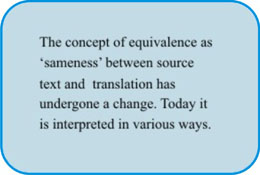|
Anton Popovic
The four kinds of equivalence that Popovic talks of – linguistic, paradigmatic, stylistic and textual – are also essentially reader-oriented. Of these, linguistic equivalence or ‘word for word' translation is not always possible and desirable. Much more than replacement of SL words with TL words, what translation aims at is ‘expressive identity' between SL and TL texts. This means that the impact of the SL text has to be reproduced even though there might not be exact linguistic equivalence. In the translation of literature with its profusion of idioms and metaphors, what the translator would aim for is stylistic equivalence. However, there will be an overlap of all these kinds of equivalence in a good translation. and textual – are also essentially reader-oriented. Of these, linguistic equivalence or ‘word for word' translation is not always possible and desirable. Much more than replacement of SL words with TL words, what translation aims at is ‘expressive identity' between SL and TL texts. This means that the impact of the SL text has to be reproduced even though there might not be exact linguistic equivalence. In the translation of literature with its profusion of idioms and metaphors, what the translator would aim for is stylistic equivalence. However, there will be an overlap of all these kinds of equivalence in a good translation.
Mukarovsky states that a literary text has an autonomous as well as communicative character – it is a complete entity in itself but it also has a message to communicate. Elaborating on the autonomous nature of a text, Lotman has argued that it is explicit, limited and has structure. It is explicit because it is expressed through definite signs, limited because it begins and ends at specific points and it has a structure because it has internal organization. Susan Bassett points out how it is important for a translator to take all of this into account before translating. S/he has to consider the text not just as an autonomous entity but also as a medium of communication; otherwise the translation would not do justice to the SL text.
The issue of equivalence has evolved and grown with the discipline of Translation Studies. There are multiple approaches to the question. One line of thought insists on semantic equivalence in the belief that translation is transfer of meanings from one language to the other. However, changing concepts of language and literature have radically altered the perception of equivalence especially with regard to literary translations. The question they ask is whether equivalence is a realizable goal or not. A translation that hopes to capture a text's essence will have to take into account its socio-cultural context also; a theoretician like Durisin feels it has to be concerned about the equivalence between artistic procedures rather than languages. There are people who feel that the equivalence that is talked about in Translation Studies should not be thought of as a mathematical precept, and that equivalence can never be ‘sameness' between SL and TL texts. |